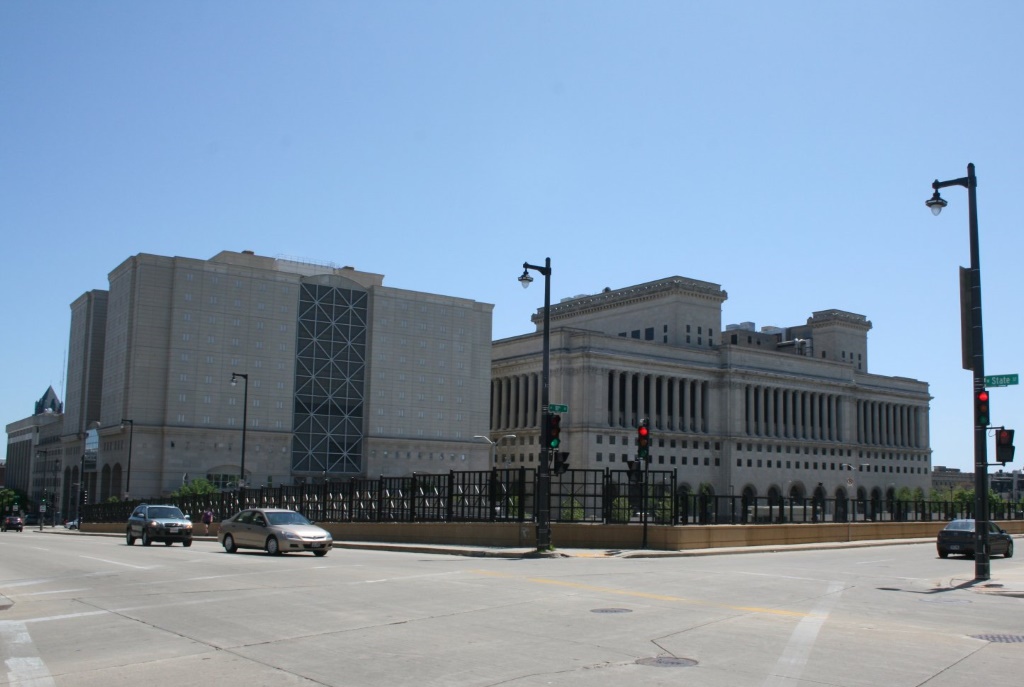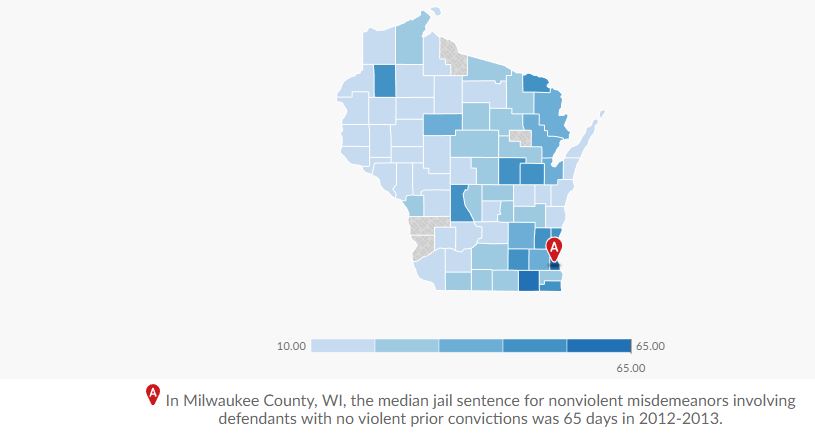County Tougher on Misdemeanors
Judges give sentences twice as long with more jailing than other counties.
Milwaukee County judges handed down longer sentences – a median of 65 days – for nonviolent misdemeanors than did other judges around the state, new data show.
The statewide median sentence was 30 days.
None of the offenders considered had a previous conviction for violence.
Milwaukee County also ranked near the top in the share of nonviolent misdemeanants it sent to jail. Pepin County was tops, at 43.3%; Milwaukee County clocked in at 37%; and statewide, the median was 27.7%.
There also was a racial disparity the length of sentences for those nonviolent misdemeanors in Milwaukee County. The median sentence for nonwhite defendants was 70 days, 17 percent longer than the 60-day median for whites.
The median is the midpoint, meaning half the sentences were longer than the median and half were shorter.
Statewide, there was no racial disparity in sentencing, though individual counties did show disparities — in six counties, nonwhite defendants were sentenced to longer terms, and in 20 counties whites received longer median sentences than nonwhites.
The data, part of the new Measures for Justice portal that made its debut Tuesday, cover the years 2012-2013.
Reducing the “misuse and overuse of jails is the mantra they gave us,” she said Wednesday.
The partners in the grant, including the courts, the district attorney’s office, the public defender’s office and others, are working to keep low-level offenders out of the criminal justice system, she said.
If methods other than criminal prosecution can be effective in dealing with those low-level crimes, she said, “we would have a substantially reduced caseload.”
The county, according to the Safety and Justice Challenge website, is focusing on three initiatives.
- Expanding a book and release program in Milwaukee city for low-level non-violent misdemeanor offenses, which is already in use in Milwaukee’s suburban districts
- Taking an integrated approach to mental health services that will allow the county to share data across agencies and provide law-enforcement with enhanced resources and alternatives other than arrest and jail
- Developing and implementing a new trauma strategy to make headway in addressing racial and ethnic disparities in the system, while also helping to appropriately drive down the county’s overall jail population.
The portal’s data on nonviolent misdemeanors is only one of the data points that can be compared across county lines for the first time. The portal is still under development and contains data for just six states, including Wisconsin.
“The data are a treasure trove for communities that will now have access to reliable, informative, and comprehensive data about their criminal justice systems,” Amy Bach, president and executive director of Measures for Justice said in a prepared statement. “Our portal is intended to be a starting point for conversations about how to address the multiple issues facing the criminal justice system.”
There are data points a user will not find on the portal — at least not yet. There are no statistics about specific crimes, for example. But the data that are available will provide new context to criminal justice discussions in the state.
More Wisconsin tidbits from Measures for Justice for the 2009-13 time span — we’ll be looking deeper into these in the coming weeks and months:
- Statewide, 17.2% of cases filed in 2009-13 were dismissed; in Milwaukee County, that percentage was 24.5%.
- Some 19.4% of cases statewide had at least one attorney withdrawal. In Milwaukee County, that percentage was 14.2%.
- Grant County took a larger share of cases to trial – 5.7% – than did any other county in the state. Some 5.6% of Milwaukee County cases went to trial, the second highest ratio in the state. Kewaunee County did not take any cases to trial. Statewide, 3.1% of cases went to trial.
Gretchen Schuldt writes a blog for Wisconsin Justice Initiative, whose mission is “To improve the quality of justice in Wisconsin by educating the public about legal issues and encouraging civic engagement in and debate about the judicial system and its operation.”
Court Watch
-
No Unemployment Benefits For Worker Making Homophobic Remarks
 May 17th, 2022 by Gretchen Schuldt
May 17th, 2022 by Gretchen Schuldt
-
Appeals Court Upholds Injunction Against Abortion Protester
 Mar 13th, 2022 by Gretchen Schuldt
Mar 13th, 2022 by Gretchen Schuldt
-
80% of State’s Judicial Races Uncontested
 Feb 20th, 2022 by Gretchen Schuldt
Feb 20th, 2022 by Gretchen Schuldt





















A few questions: where do patterns come from? When did a pattern start? And when does it become normative, “the way we do things here”? Many years ago, I was a student intern in the County Budget Office. I would have time to go sit in courtrooms and watch trials. I spent a fair amount of time in Judge Seraphim’s court because it was the most entertaining. It didn’t take long to see a very clear pattern. When the defendant was white, the judge would say something along the following lines: “I’m going to give you a break this time, but I don’t ever want to see you in this courtroom again.” On the other hand, if the defendant were black, it would be, “I’m going to make an example out of you.” And he would impose a harsh sentence for some small offense, including kicking people out of Milwaukee, which he, like others, viewed as exiling them from paradise.
Did Seraphim and others create norms that have persisted to this day? Beats me, but it sure is an interesting coincidence.
It’s clear we need to get those offenders back into their communities as soon as possible. Thank goodness for the Justice Challenge Grant! I mean, we now have women hanging onto their car hoods trying to prevent them being jacked in broad daylight… clearly, over-imprisonment is a big challenge facing us.
WashCoRepub: I’m not sure that your comment a response to my remark, but it appears to have been; and, if so, let me clarify, or possibly help with what may be a reading comprehension challenge. I very consciously used the term “very small offense.” To expand, these include(d) things like shoplifting, urinating in an alley, drinking on the street, or somehow cheating on public assistance. I know of no one who would consider carjacking a “very small offense.” It’s not nice to distort other people’s remarks.
Do they track percentage of charges that were reduced to misdemeanors when they should be felonies or violent offenses?
AG – They do track some plea bargains. I don’t think they make judgments about “should,” though.
Frank it is good to see you were entertained by a racist. We put these judges on such high pedestals. No one confronts power.
In GOP counties they teach you that one anecdote is solid and reliable evidence.
AG knows best and knows what “should” be a felony.
Vincent, why always so combative? Don’t you think it would be interesting to see how counties compare in plea bargaining?
There is always monetary benefit for vendors, consultants, etc., by warehousing people in jail. For those who profit from the logistics of incarceration, the more the merrier! As Bob Dylan said, “Everybody must get stoned!” Then again, there are always costs to leaving the bell-shaped curve of humanity wandering loose, unchecked, untracked, unmonitored, un-counseled, unmedicated, etc. etc. Those who believe in other sanctions (not to include cruel and unusual punishment), may say ‘”let my people go”…all of ’em’. The answer to this dichotomy: penal colonies. Let’s move out the transgressors to their own lands where they can roam free and “do what thou wilt” while we who remain in the wholesome world enact strict cultural pressures and biases to enforce conformation to predictably and statistically safer cultural mores.
I thought the Walker/Vos playbook was to just make Milwaukee the colony… huh, I wonder how I got that impression.